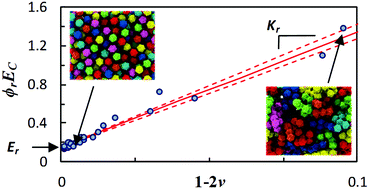Poisson ratio mismatch drives low-strain reinforcement in elastomeric nanocomposites
Abstract
Introduction of nanoparticulate additives can dramatically impact elastomer mechanical response, with large enhancements in modulus, toughness, and strength. Despite the societal importance of these effects, their mechanistic origin remains unsettled. Here, using a combination of theory and molecular dynamics simulation, we show that low-strain extensional reinforcement of elastomers is driven by a nanoparticulate-jamming-induced suppression in the composite Poisson ratio. This suppression forces an increase in rubber volume with extensional deformation, effectively converting a portion of the rubber's bulk modulus into an extensional modulus. A theory describing this effect is shown to interrelate the Poisson ratio and modulus across a matrix of simulated elastomeric nanocomposites of varying loading and nanoparticle structure. This model provides a design rule for structured nanoparticulates that maximizes elastomer mechanical response via suppression of the composite Poisson ratio. It also positions elastomeric nanocomposites as having a qualitatively different character than Poisson-ratio-matched plastic nanocomposites, where this mechanism is absent.



 Please wait while we load your content...
Please wait while we load your content...